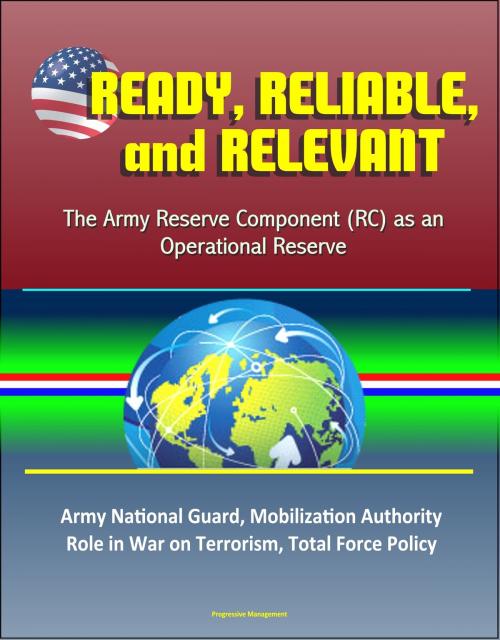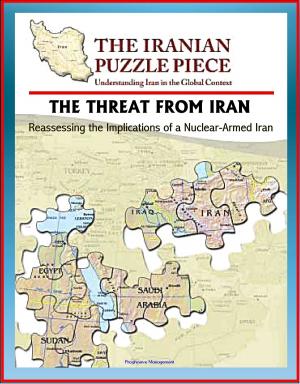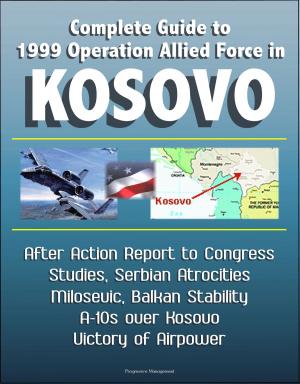Ready, Reliable, and Relevant: The Army Reserve Component (RC) as an Operational Reserve – Army National Guard, Mobilization Authority, Role in War on Terrorism, Total Force Policy
Nonfiction, History, Military, Strategy, United States| Author: | Progressive Management | ISBN: | 9781370803330 |
| Publisher: | Progressive Management | Publication: | March 3, 2017 |
| Imprint: | Smashwords Edition | Language: | English |
| Author: | Progressive Management |
| ISBN: | 9781370803330 |
| Publisher: | Progressive Management |
| Publication: | March 3, 2017 |
| Imprint: | Smashwords Edition |
| Language: | English |
This excellent report has been professionally converted for accurate flowing-text e-book format reproduction. The Army Reserve Component (RC) has a major role in America's Global War on Terror (GWOT). Over the past decade and a half, the Army National Guard (ARNG) and the United States Army Reserve (USAR) have mobilized hundreds of thousands of Soldiers in support of contingency operations in Iraq and Afghanistan, as well as to numerous other missions worldwide and throughout the Continental United States (CONUS). They have proven their capabilities and exceeded operational expectations, successfully transitioning from the strategic reserve force of the Cold War era to a well-trained and experienced operational reserve force of the GWOT era. The problem facing the Department of Defense (DOD), is determining the future utilization of RC forces, specifically their operational role, their implementation, and the development of a suitable mobilization authority that will support a broad spectrum of future operational requirements. This monograph presents two primary arguments. First, the Army RC should continue its role as an operational reserve in support of future operational requirements. Second, continuing the use of the Army RC as an operational reserve requires the implementation of a new mobilization authority, one that will be more lasting, functional, and suitable for the current operating environment. This monograph presents two key proposals including the sustainment of the RC as an operational reserve, and a comprehensive plan for the implementation of a new mobilization authority. The action plan for these proposals includes a recommended framework and guidelines for a new mobilization authority that will achieve the goals of maintaining the use of RC forces as an operational reserve while modernizing the mobilization process to meet the demands of the current operating environment. A new and improved mobilization authority will allow Army RC forces to remain ready, reliable and relevant, capable of supporting future operational requirements of the 21st century.
This monograph presents two primary arguments. First, the Army RC should continue its role as an operational reserve in support of future operational requirements. Second, continuing the use of the Army RC as an operational reserve requires the implementation of a new mobilization authority, one that will be more lasting, functional, and suitable for the current operating environment. There are five principal factors supporting the continued use of the Army RC as an operational reserve. First, over three quarters of a million Army RC Soldiers representing a large scale of ARNG and USAR units have mobilized since September 11, 2001 (9/11) in support of OEF, OIF, OND, and ONE, demonstrating the proven capabilities and very significant operational role of the Army RC in America's GWOT. 2 Second, as the Regular Army (RA) decreases its end strength, projected to fall to as low as 440,000 to 450,000 Soldiers by 2019, the RC can expect ongoing mobilizations and a substantial operational role. Third, current force structure allocations include a large volume of the Army's critical support units in the RC, including sustainment units and those historically categorized as combat support (i.e., chemical, engineer, military police, and signal units), as well as civil affairs and medical units. Maintaining such a large volume of the Army's support force structure in the RC increases the likelihood of their operational use for future operational requirements.
This excellent report has been professionally converted for accurate flowing-text e-book format reproduction. The Army Reserve Component (RC) has a major role in America's Global War on Terror (GWOT). Over the past decade and a half, the Army National Guard (ARNG) and the United States Army Reserve (USAR) have mobilized hundreds of thousands of Soldiers in support of contingency operations in Iraq and Afghanistan, as well as to numerous other missions worldwide and throughout the Continental United States (CONUS). They have proven their capabilities and exceeded operational expectations, successfully transitioning from the strategic reserve force of the Cold War era to a well-trained and experienced operational reserve force of the GWOT era. The problem facing the Department of Defense (DOD), is determining the future utilization of RC forces, specifically their operational role, their implementation, and the development of a suitable mobilization authority that will support a broad spectrum of future operational requirements. This monograph presents two primary arguments. First, the Army RC should continue its role as an operational reserve in support of future operational requirements. Second, continuing the use of the Army RC as an operational reserve requires the implementation of a new mobilization authority, one that will be more lasting, functional, and suitable for the current operating environment. This monograph presents two key proposals including the sustainment of the RC as an operational reserve, and a comprehensive plan for the implementation of a new mobilization authority. The action plan for these proposals includes a recommended framework and guidelines for a new mobilization authority that will achieve the goals of maintaining the use of RC forces as an operational reserve while modernizing the mobilization process to meet the demands of the current operating environment. A new and improved mobilization authority will allow Army RC forces to remain ready, reliable and relevant, capable of supporting future operational requirements of the 21st century.
This monograph presents two primary arguments. First, the Army RC should continue its role as an operational reserve in support of future operational requirements. Second, continuing the use of the Army RC as an operational reserve requires the implementation of a new mobilization authority, one that will be more lasting, functional, and suitable for the current operating environment. There are five principal factors supporting the continued use of the Army RC as an operational reserve. First, over three quarters of a million Army RC Soldiers representing a large scale of ARNG and USAR units have mobilized since September 11, 2001 (9/11) in support of OEF, OIF, OND, and ONE, demonstrating the proven capabilities and very significant operational role of the Army RC in America's GWOT. 2 Second, as the Regular Army (RA) decreases its end strength, projected to fall to as low as 440,000 to 450,000 Soldiers by 2019, the RC can expect ongoing mobilizations and a substantial operational role. Third, current force structure allocations include a large volume of the Army's critical support units in the RC, including sustainment units and those historically categorized as combat support (i.e., chemical, engineer, military police, and signal units), as well as civil affairs and medical units. Maintaining such a large volume of the Army's support force structure in the RC increases the likelihood of their operational use for future operational requirements.















